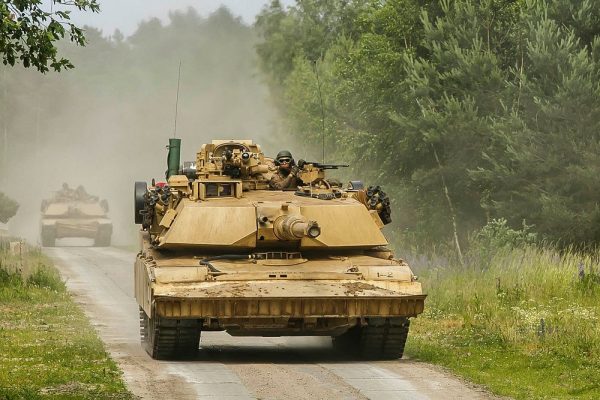The following article was first published in Warrior Maven, a Military Content Group member website. Attack drone swarms, mobile anti-armor weapons and hit and run ambush-style attacks have all simply decimated Russia’s tank force, a development that continues to inspire international attention to the utility and potential combat vulnerability of heavy armor and mechanized maneuver. Countless media reports continue to emphasize the vulnerability of tanks, something which has in part helped generate new concepts of operation. The US Marine Corps Force Design 2030, which specifically cites lessons learned from the Ukraine war, calls for a massive reduction in the service’s force of tanks. The Corps subsequently decided to divest its force of tanks in favor of a lighter, faster, and more expeditionary lethal force using an increased number of drones and anti-armor weapons for high-speed multi-domain attacks. However, the circumstances are quite different for the Army, which has consistently upgraded its fleet of Abrams tanks and made tactical adjustments to ensure their continued relevance. There do appear to be many key variables that many of the reports about tank destruction in Ukraine appear to miss to a certain extent.
There appear to be many reasons why the tank is here to stay, particularly if upgraded. Modern applications of what could be identified as traditional Combined Arms Maneuver using heavier platforms such as tanks continues to show great combat effectiveness, particularly when paired with reconnaissance and targeting units, advanced ISR and a new generation of networking and command and control technology. Mechanized assault, something aligned with the Army Wide Area Maneuver concept of operation, not only continues to occupy a key place in modern warfare but will arguably take on even more tactical relevance in coming years as emerging technologies in the areas of unmanned systems, AI-enabled computing, sensor image fidelity, target-data transmission contribute to more survivable attack formations and the successful application of longer-range precision weaponry. Army Research Laboratory scientists, for example, talked to Warrior a few years ago about breakthrough progress with AI-empowered technology able to autonomously land a drone on a moving tank using advanced sensing and machine learning.
What this amounts to is that emerging technologies and tactics continue to make the tank more effective and indispensable in modern land war. Recently, tanks and heavier armored vehicles were instrumental in generating the initial success of Ukraine’s Kursk offensive by using forward reconnaissance units likely in position to identify weak points in the Russian perimeter. The effective employment of ISR and networked command and control likely enabled mechanized units to blast and maneuver through Russian defenses. In this respect, massively upgraded traditional tank platforms can use modern technologies, upgraded sensing and longer-range weapons to adapt tactics and remain extremely effective in a modern threat environment.
Throughout much of the region along the border areas of operating Russian troops, there continue to be extremely lethal layered defenses, mines, barbed wire and ditches making it difficult for tanks to break through or even operate. This is especially true given the widespread use of attack drones and anti-armor weapons which have had a devastating impact upon heavy armor in the Ukraine-Russia war. However, when combined with advanced reconnaissance, networking and improved command and control, tanks seem to have proven to be uniquely valuable in Ukraine’s Kursk offensive. An essay in the BBC cited sources indicating that Britain’s Challenger 2 tank was successfully employed during the Kursk offensive, and it appears maneuvering tanks were likely able to use ISR to find weaker, more penetrable parts of Russia’s defenses. This enabled Ukrainian armored units to use an element of surprise and attack areas less fortified by barbed wire, attack drone swarms, anti-armor weapons and mines. What this demonstrates is that the firepower and pure mechanized attack “force” of a modern upgraded main battle tank, can perform critical, unique, much needed functions if used properly in a modern threat environment.
This effective employment of mechanized maneuver formations by the Ukrainians was well articulated in a recent essay from West Point’s Modern War Institute which identified Ukraine’s successful effort to “bring maneuver back.” The essay, written by US Army writing fellow Major. Robert G. Rose, is called “The Kursk Offensive: How Ukraine’s Operational-Level Guerrilla Warfare is Brining Maneuver Back.”
Ukraine “conducted small raids to probe for Russian vulnerabilities with the 80th and 82nd Air Assault Brigades and then exploited them with mechanized forces. Ukraine has once again shown that maneuver requires identifying a vulnerability and exploiting it with a speed that prevents the enemy from addressing that vulnerability,” (Robert G. Rose, US Army, is a Lt. Gen. (Ret.) James M. Dubik writing fellow and serves as the commander for Alpine Troop, 3rd Squadron, 4th Security Force Assistance Brigade)
Accordingly, the Modern War Institute essay seems to suggest that, when utilized in tandem with advanced ISR and adjusted tactics, maneuver warfare using tanks can arguably be more effective than ever. Stand-off ISR, coupled with small, mobile, forward-operating reconnaissance teams, can enable tactical tank maneuvers to achieve a measurable combat effect, as evidenced by Ukraine’s offensive. Certainly the Abrams heavier weight can restrict mobility and the effective use of anti-armor weapons are changing tactics and concepts of operation for how best to employ tanks in combat, there is a distinct combat value offered by tanks which is nearly impossible to replicate. The US Army seems to understand this, which is why it is both developing lighter-weight and unmanned armored attack vehicles while also deploying upgraded Abrams tanks as well. The prevailing US Army consensus seems to be that both approaches are greatly needed, and they can be greatly optimized by reinforcing and utilizing one another.
The following article was first published in Warrior Maven, a Military Content Group member website. Attack drone swarms, mobile anti-armor weapons and hit and run ambush-style attacks have all simply decimated Russia’s tank force, a development that continues to inspire international attention to the utility and potential combat vulnerability of heavy armor and mechanized maneuver. Countless media reports continue to emphasize the vulnerability of tanks, something which has in part helped generate new concepts of operation. The US Marine Corps Force Design 2030, which specifically cites lessons learned from the Ukraine war, calls for a massive reduction in the service’s force of tanks. The Corps subsequently decided to divest its force of tanks in favor of a lighter, faster, and more expeditionary lethal force using an increased number of drones and anti-armor weapons for high-speed multi-domain attacks. However, the circumstances are quite different for the Army, which has consistently upgraded its fleet of Abrams tanks and made tactical adjustments to ensure their continued relevance. There do appear to be many key variables that many of the reports about tank destruction in Ukraine appear to miss to a certain extent.
There appear to be many reasons why the tank is here to stay, particularly if upgraded. Modern applications of what could be identified as traditional Combined Arms Maneuver using heavier platforms such as tanks continues to show great combat effectiveness, particularly when paired with reconnaissance and targeting units, advanced ISR and a new generation of networking and command and control technology. Mechanized assault, something aligned with the Army Wide Area Maneuver concept of operation, not only continues to occupy a key place in modern warfare but will arguably take on even more tactical relevance in coming years as emerging technologies in the areas of unmanned systems, AI-enabled computing, sensor image fidelity, target-data transmission contribute to more survivable attack formations and the successful application of longer-range precision weaponry. Army Research Laboratory scientists, for example, talked to Warrior a few years ago about breakthrough progress with AI-empowered technology able to autonomously land a drone on a moving tank using advanced sensing and machine learning.
What this amounts to is that emerging technologies and tactics continue to make the tank more effective and indispensable in modern land war. Recently, tanks and heavier armored vehicles were instrumental in generating the initial success of Ukraine’s Kursk offensive by using forward reconnaissance units likely in position to identify weak points in the Russian perimeter. The effective employment of ISR and networked command and control likely enabled mechanized units to blast and maneuver through Russian defenses. In this respect, massively upgraded traditional tank platforms can use modern technologies, upgraded sensing and longer-range weapons to adapt tactics and remain extremely effective in a modern threat environment.
Throughout much of the region along the border areas of operating Russian troops, there continue to be extremely lethal layered defenses, mines, barbed wire and ditches making it difficult for tanks to break through or even operate. This is especially true given the widespread use of attack drones and anti-armor weapons which have had a devastating impact upon heavy armor in the Ukraine-Russia war. However, when combined with advanced reconnaissance, networking and improved command and control, tanks seem to have proven to be uniquely valuable in Ukraine’s Kursk offensive. An essay in the BBC cited sources indicating that Britain’s Challenger 2 tank was successfully employed during the Kursk offensive, and it appears maneuvering tanks were likely able to use ISR to find weaker, more penetrable parts of Russia’s defenses. This enabled Ukrainian armored units to use an element of surprise and attack areas less fortified by barbed wire, attack drone swarms, anti-armor weapons and mines. What this demonstrates is that the firepower and pure mechanized attack “force” of a modern upgraded main battle tank, can perform critical, unique, much needed functions if used properly in a modern threat environment.
This effective employment of mechanized maneuver formations by the Ukrainians was well articulated in a recent essay from West Point’s Modern War Institute which identified Ukraine’s successful effort to “bring maneuver back.” The essay, written by US Army writing fellow Major. Robert G. Rose, is called “The Kursk Offensive: How Ukraine’s Operational-Level Guerrilla Warfare is Brining Maneuver Back.”
Ukraine “conducted small raids to probe for Russian vulnerabilities with the 80th and 82nd Air Assault Brigades and then exploited them with mechanized forces. Ukraine has once again shown that maneuver requires identifying a vulnerability and exploiting it with a speed that prevents the enemy from addressing that vulnerability,” (Robert G. Rose, US Army, is a Lt. Gen. (Ret.) James M. Dubik writing fellow and serves as the commander for Alpine Troop, 3rd Squadron, 4th Security Force Assistance Brigade)
Accordingly, the Modern War Institute essay seems to suggest that, when utilized in tandem with advanced ISR and adjusted tactics, maneuver warfare using tanks can arguably be more effective than ever. Stand-off ISR, coupled with small, mobile, forward-operating reconnaissance teams, can enable tactical tank maneuvers to achieve a measurable combat effect, as evidenced by Ukraine’s offensive. Certainly the Abrams heavier weight can restrict mobility and the effective use of anti-armor weapons are changing tactics and concepts of operation for how best to employ tanks in combat, there is a distinct combat value offered by tanks which is nearly impossible to replicate. The US Army seems to understand this, which is why it is both developing lighter-weight and unmanned armored attack vehicles while also deploying upgraded Abrams tanks as well. The prevailing US Army consensus seems to be that both approaches are greatly needed, and they can be greatly optimized by reinforcing and utilizing one another.
This kind of thinking aligns with the US Army’s evolving approach to modern applications of Combined Arms Maneuver. While lightweight platforms, expeditionary maneuvers and anti-armor weapons are now being emphasized to great effect, the US Army also seems to recognize that tanks, if properly fortified with upgrades and cutting edge tactics, can still prove critical if not indispensable to land-combat. Longer-range, high-fidelity thermal sensors, paradigm-changing kinds of on-board computing and command and control and the effective use of “manned-unmanned” teaming tactics can make the tank extremely lethal, formidable and effective in a high-tech modern threat environment. The key is to combine both technological upgrades and new concepts of operation in tandem with one another to optimize the effectiveness of the tank. Overhead and ground unmanned systems, for example, can ensure a tank does not approach areas where it would prove extremely vulnerable to anti-armor weapons, mines or drone swarms operating as explosives.
The Army’s upgrades to the now deployed General Dynamics M1A2 SEP Abrams V3, for example, incorporates a suite of paradigm-changing technologies which, if combined with modern tactics and concepts of operations, can make the tank platform uniquely valuable when it comes to breaking through an enemy formation and actually “holding” enemy ground. Although the Ukrainian Abrams tanks are export variants, they may contain some critical upgrades; the US Army’s V3 operates with a 3rd generation Forward Looking Infrared sensor, advanced computing and data management, new applications of command and control and an autoloader for a new generation of ammunition engineered with a key new “datalink.” These enhancements, when combined with AI-enabled computing, an ability to network in real time with air-and-ground drones and an integrated multi-domain tactical approach, can enable tanks to leverage their unique value in a manner that seems to align with how Ukraine succeeded with its Kursk advance. Certainly networked, multi-domain ISR can identify threats, targets and areas of approach to avoid, yet it can also help enable avenues of attack maneuver uniquely capable of taking and holding new ground by breaking through and destroying enemy defenses with heavy firepower and maneuver to contact.
A manned tank, operating in a command and control capacity at a safe stand-off distance, can test an enemy perimeter with forward unmanned surveillance, identify targets, obstacles and key terrain and even conduct weapons attacks when directed by a human. The US Army is well-aware of these concepts of operation, as they continue to inform the services modernization and technology development focus.
Russian Tank Maneuver
Russia’s use of tanks, by contrast, does not appear to leverage adjusted tactics or upgraded tanks, a circumstance likely responsible for the widespread destruction of its fleet. Without sufficient networking, ISR technology and integrated, joint maneuver, Russia’s tanks have proved to be extremely vulnerable. This is due to Ukraine’s effective tactical use of anti-amor weapons to stage hit-and-run ambush attacks from dispersed, decentralized dismounted mobile groups of fighters. The result has been devastating for Russia, according to a recently published Army intel analysis called “The Operational Environment 2024-2034 Large-Scale Combat Operations.” (US Army Training and Doctrine Command, G2). After conducting extensive analysis of the current war, the report found that Russia’s entire “active duty tank force” of more than 3000 tanks … has been destroyed. The tanks Russia is using, therefore, are not likely to have many upgrades and remain quite vulnerable. Also, while Russia employs many attack drones, it is not clear if the Russian Army is executing any kind of adapted or modern Combined Arms Maneuver in any substantial way.



